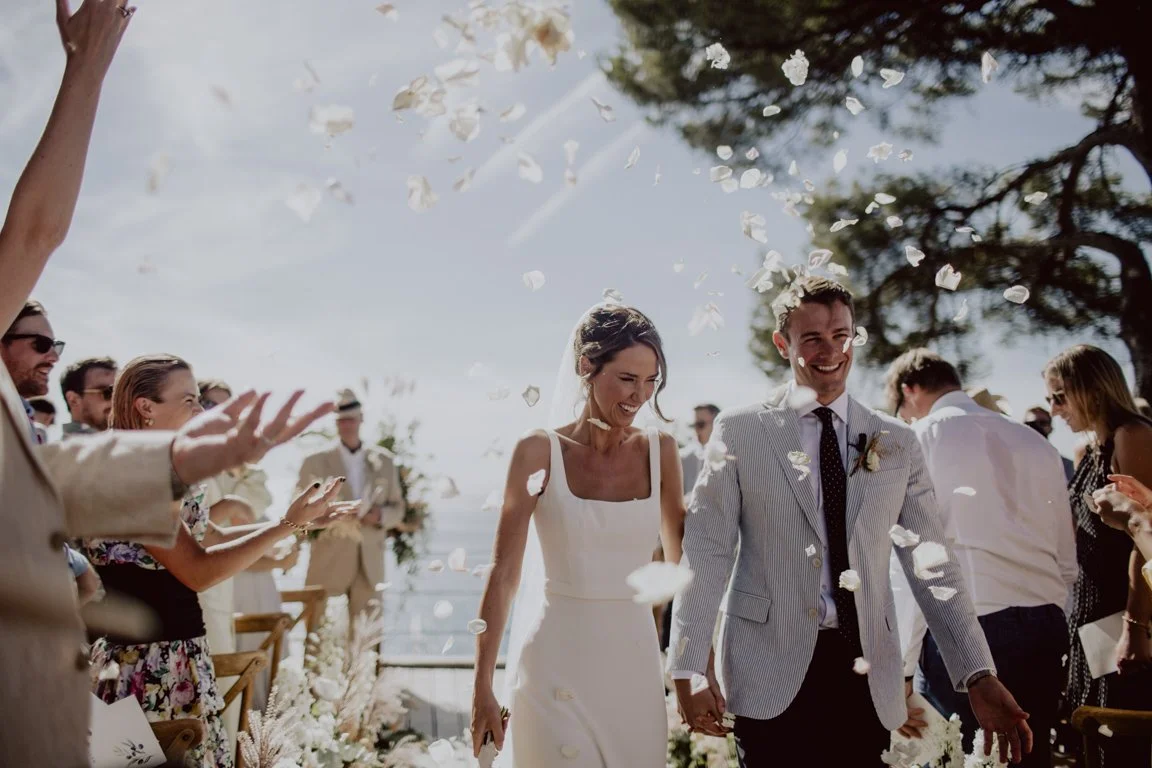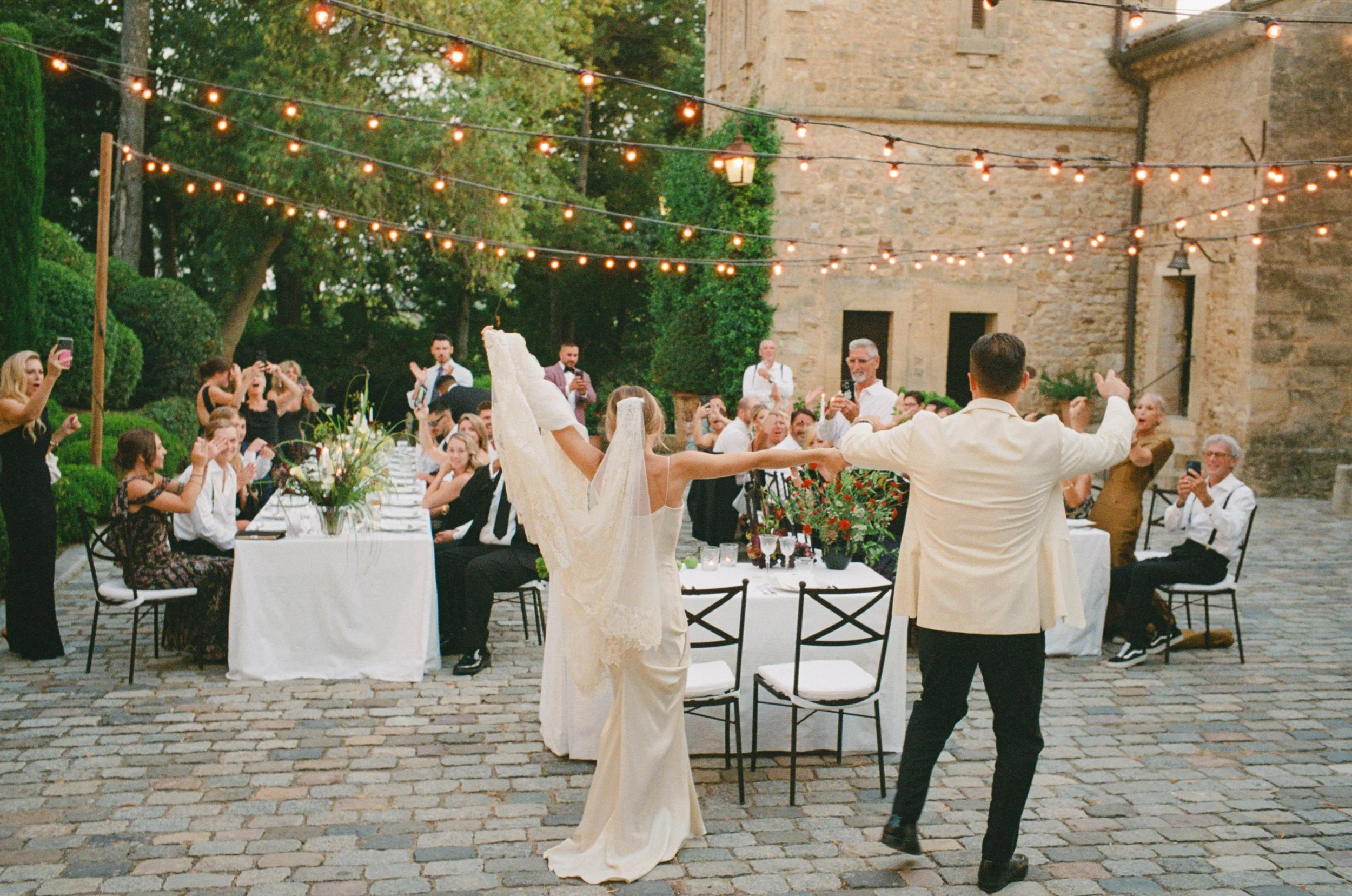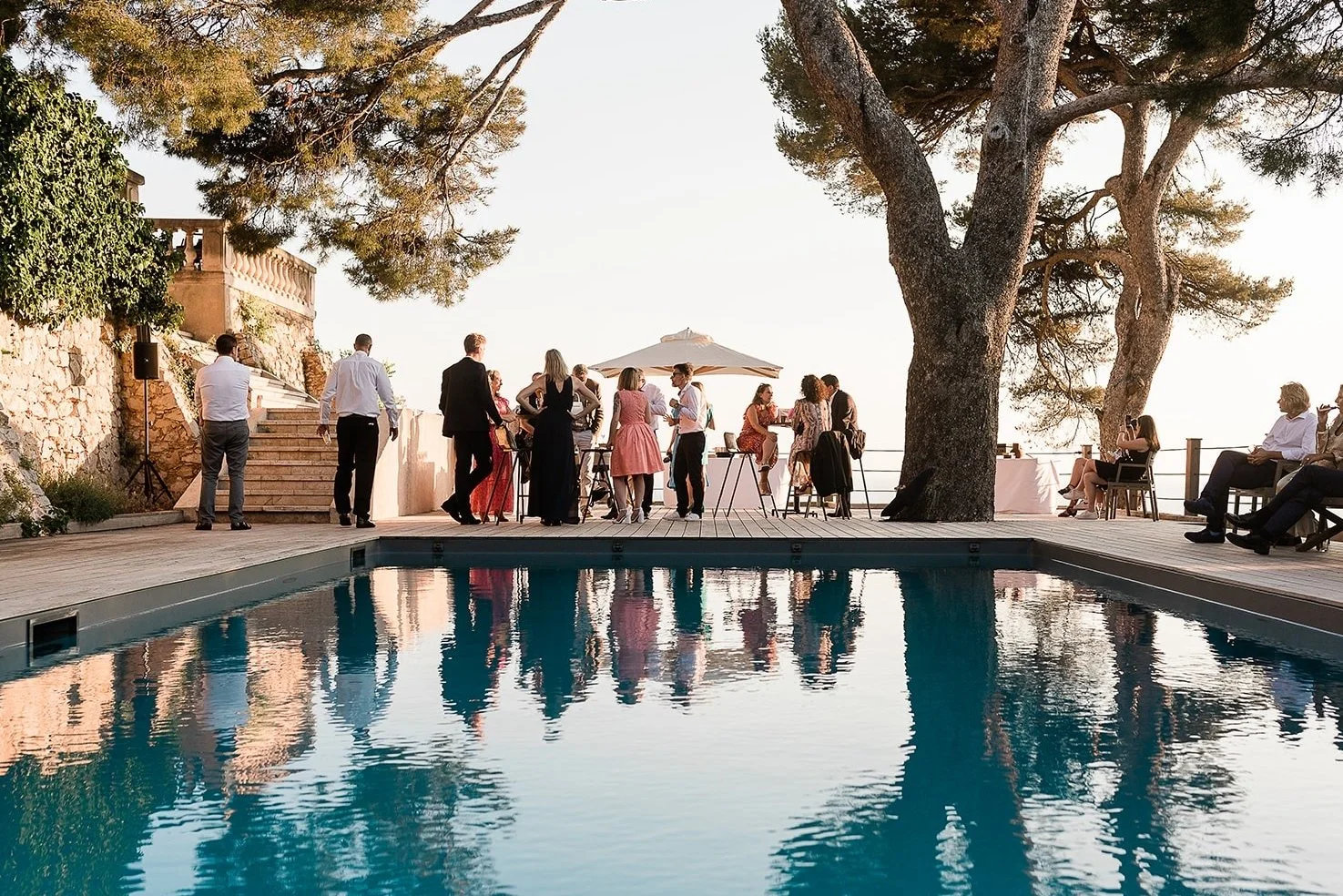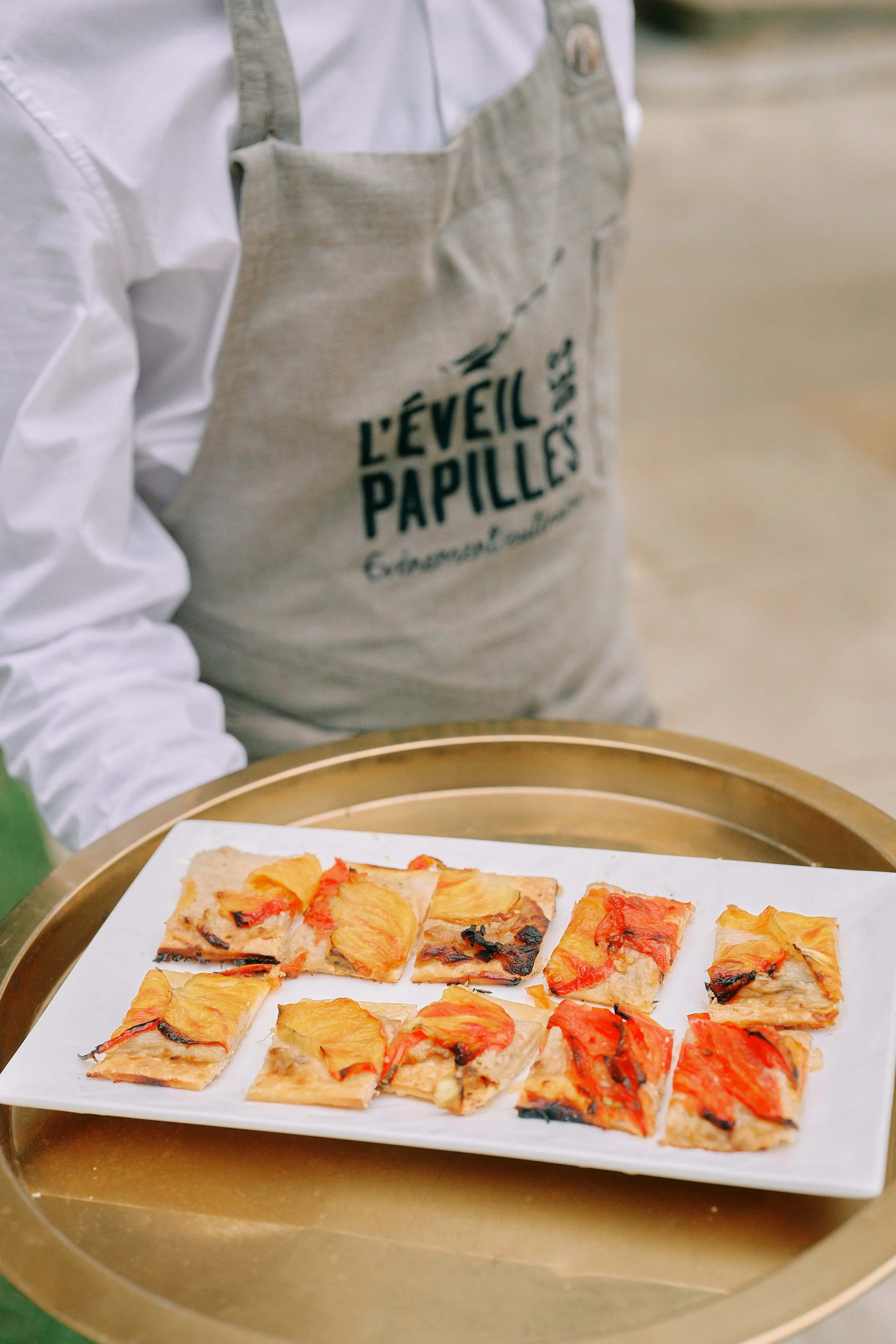The Top French Wedding Traditions
Published on August 20, 2025 | Reading time: 10 min
By Laurine Baille, Marketing at HOMANIE
Summary
For many, the very idea of France evokes romance: cobblestone streets in Paris, candlelit dinners in Provence, vineyards stretching across rolling hills, and timeless elegance at every corner. It’s no wonder that French weddings have become the ultimate dream for couples around the world. With their perfect balance of tradition, sophistication, and joie de vivre, they offer an experience unlike any other.
From the mandatory town hall ceremony to the lavish late-night receptions that end at sunrise, French weddings are not just events, they are cultural experiences. They place emphasis on gastronomy, family, and style, weaving together centuries-old traditions with modern touches of refinement.
Whether you’re planning to say “I do” in a historic south of france château wedding venue, exchange vows in a vineyard under the Provençal sun, or host an intimate celebration overlooking the Eiffel Tower or in a luxury wedding venue near paris, understanding the key French wedding traditions will help you create an authentic and unforgettable celebration.
At Homanie, we specialize in turning these dreams into reality for international couples. With access to a portfolio of exclusive venues across France and a tailored approach to planning, we ensure that your wedding combines French elegance with seamless coordination so you can focus on what matters most: celebrating your love
The Ceremony: A Blend of Legal and Emotional Moments
A French wedding begins not with grand theatrics, but with time-honored traditions that balance formality and intimacy. While American ceremonies often focus on a dramatic first look, a bridal party entrance, and long vows, the French approach feels more understated and yet no less meaningful.
The civil ceremony at the town hall
In France, love meets the law. Every couple, regardless of religion, must first marry at the mairie (town hall). Conducted by the mayor, this ceremony is the only one recognized legally. It is brief, usually around 20 minutes, but carries profound symbolism. Often, only close family and the couple’s official witnesses attend. Many French couples choose to have this ceremony a day before the larger celebration, while international couples often blend it into their wedding day.
Religious or symbolic ceremony
After the mairie, couples may host a second ceremony religious or secular. A church wedding brings traditional gravitas, often accompanied by classical music and a solemn exchange of vows. Increasingly, couples choose a symbolic ceremony outdoors: in vineyard rows, under olive trees in Provence, or in the courtyard of a French château. Unlike American weddings, where décor can lean extravagant, French ceremonies are elegant and restrained, placing emphasis on the moment itself.
The wedding procession
Forget the American-style bridal party with matching bridesmaids’ dresses and groomsmen in coordinated suits. In France, the entrance procession is led by family members and the chosen witnesses (témoins). These witnesses play a legal and symbolic role, they are officially recorded in the marriage contract. This emphasis on family over bridal parties makes French ceremonies feel more intimate and rooted in tradition.
No “first look” tradition
In the U.S., many couples arrange a private “first look” for photos before the ceremony. In France, the magic happens when the bride enters the ceremony space and the groom sees her for the first time in front of their loved ones. This collective moment of discovery is emotional, authentic, and often unforgettable.
Petals, rice, or bubbles
When the couple exits the ceremony, guests shower them not with orchestrated confetti cannons, but with simple gestures of joy: rose petals, rice, or bubbles. It’s a charming way to honor the newlyweds, in keeping with the French preference for elegance over spectacle.
The vin d’honneur: a uniquely French tradition
Once vows are exchanged, the couple invites their guests to a vin d’honneur: a cocktail reception bridging the ceremony and the dinner. Here, Champagne flows, canapés are served, and live music often sets the tone. Unlike in the U.S., this part of the day welcomes a broader circle of acquaintances, while the dinner remains more intimate. It’s a cultural hallmark of the French wedding: conviviality without excess.
“In France, the wedding ceremony is not only a legal union but also a deeply symbolic moment, where traditions blend with cultural rituals that reflect the couple’s heritage. This mix of formality and emotion makes French weddings uniquely timeless.”
- Marie Treppoz, Co-founder
The Attire: Effortless French Elegance
French countryside weddings are often admired for their style, and nowhere is this more evident than in the attire. While American weddings sometimes lean toward bold statements or highly coordinated bridal parties, the French aesthetic favors timeless elegance, simplicity, and subtle sophistication. It’s not about making the biggest impression, it’s about embodying refinement in a way that feels natural and chic.
The bride: understated glamour over extravagance
French brides tend to embrace a look that is elegant, effortless, and refined rather than extravagant. The gowns are usually sleek and beautifully tailored, often featuring lace, silk, or minimalist cuts that highlight the bride’s natural beauty. Instead of the voluminous “princess-style” dresses often chosen in the U.S., French brides opt for designs that are chic but not overwhelming. Accessories are minimal yet meaningful perhaps a delicate veil, a floral crown, or vintage jewelry passed down through generations.
Makeup and hair also reflect this philosophy: the French bride is polished, but never overdone. Think soft waves, a natural glow, and a touch of Parisian red lipstick if it suits her personality. The overall impression is of a bride who looks like herself, simply elevated for one of the most important days of her life.
The groom: tailoring and timelessness
For the groom, the emphasis is on fit and quality over flashiness. A well-cut suit in navy, charcoal, or black is the classic choice, often paired with subtle accessories like cufflinks or a pocket square. Some grooms wear a three-piece suit, while others opt for a more modern slim fit. What they avoid are overly bold colors or eccentric styles: French grooms prefer to look timeless, ensuring their wedding photos will never feel dated.
There is also a sense of harmony between the couple’s outfits. While Americans sometimes see the bride as the focal point of the day, in France the groom is expected to match her elegance, creating a balanced aesthetic of shared sophistication.
Witnesses and guests: chic, refined, and never over the top
One of the biggest differences Americans notice at French weddings is the absence of a formal bridal party dressed in matching outfits. Instead, French couples select a few official witnesses (témoins), who have legal standing in the marriage contract but do not wear coordinated attire. This keeps the focus on the couple and their families rather than a large group of bridesmaids and groomsmen.
For guests, the dress code is almost always chic but discreet. Women may wear cocktail dresses or elegant evening gowns, but rarely anything flashy or sparkling. Men usually opt for suits, but tuxedos are uncommon unless the wedding is explicitly black-tie. Above all, there are two golden rules: never wear white (a color strictly reserved for the bride) and avoid overdressing. The French approach is about subtle elegance, not competition.
The Reception: A Celebration of Gastronomy and Joy
If there is one moment where French culture truly shines, it is the wedding reception. Unlike in the U.S., where receptions may emphasize speeches, choreographed dances, and large-scale entertainment, the French wedding dinner is first and foremost about food, wine, and conviviality. The reception is not simply a meal, it is an unforgettable journey through flavors, traditions, and celebrations that last until sunrise.
The vin d’honneur: welcoming guests with Champagne and elegance
The French reception begins with the vin d’honneur, a cocktail-style gathering held after the ceremony. This is a uniquely French tradition that allows couples to welcome a wider circle of friends, colleagues, and acquaintances without hosting them at the formal dinner. Guests are greeted with glasses of Champagne or sparkling wine, paired with delicate canapés, petits fours, or local specialties.
What makes the vin d’honneur so special is its atmosphere: convivial yet elegant, often held outdoors in a château courtyard or vineyard garden. It’s less formal than the dinner but still refined, offering couples the chance to mingle with guests in a relaxed setting. For Americans, it can feel like a cross between a cocktail hour and a garden party, but with that distinct French flair for elegance and effortless hospitality.
The gastronomic dinner: an art form in itself
After the vin d’honneur comes the highlight of the evening: the multi-course French dinner. In France, food is never an afterthought, it is the centerpiece of the celebration. Couples work closely with caterers or chefs to curate a menu that might include an appetizer, main course, cheese selection, and dessert, all paired with carefully chosen wines.
Unlike American weddings, where buffets are common, French weddings almost always feature seated service, with each course elegantly plated. Wines are not just poured but often presented, showcasing the terroir of the region. And then comes the dessert: instead of a towering layer cake, the traditional choice is the pièce montée, or croquembouche: a spectacular tower of caramel-glazed choux pastries. This dazzling centerpiece is brought into the room with ceremony, often to applause, making it a truly French wedding moment.
For Americans used to fast-paced receptions, the French dinner may seem long, it can last three to four hours but it is designed to be savored, with each course unfolding slowly like a performance.
The dance floor: celebrating until sunrise
If American weddings often end around midnight, the French are just getting started. Once dessert is served, the dance floor opens and it stays open until the early hours of the morning. The newlyweds traditionally lead the first dance, often to a romantic song or a classic French waltz, before guests join in.
The energy builds as the night goes on, with playlists blending international hits, French classics, and sometimes even live music. Playful traditions like the farandole (a lively group dance) or a conga line often emerge in the late hours, when Champagne and joy keep spirits high. For many guests, the best memories come from these spontaneous, carefree moments shared long after midnight.
With Homanie, couples can host receptions in some of the most beautiful luxury wedding venues in France, where the atmosphere, cuisine, and music come together seamlessly. From curating a Michelin-trained chef to arranging live bands or DJs, we ensure your reception captures the true spirit of a French wedding: elegant, joyful, and unforgettable.
French Wedding Etiquette: What American Guests Should Know
For Americans attending or hosting a luxury wedding in France, the beauty of the day lies not just in the location or the cuisine, but also in the unspoken rules of etiquette that guide the celebration. French weddings are elegant and joyful, but they follow certain customs that may surprise international guests. Understanding these will help you feel at ease and avoid any faux pas.
Assigned seating: the importance of the plan de table
Unlike in the U.S., where guests often choose their own seats, French weddings almost always include a carefully designed seating plan. The couple spends significant time arranging the “plan de table” to encourage conversation and balance groups. It’s common to mix families, friends, and even strangers at the same table to create lively discussions. For American guests, this may feel unusual, but it’s a cherished French tradition that reflects the value placed on community and shared experience.
Dress code: chic but never ostentatious
In France, style is everything but it is always subtle, never excessive. Guests are expected to dress elegantly, whether in cocktail attire or evening wear, but should avoid anything too bold, flashy, or attention-grabbing. The golden rule: never wear white, as that color belongs solely to the bride. Black tie attire is uncommon unless explicitly stated, and hats, so common in British weddings, are rare. The French aesthetic is about blending in gracefully rather than standing out.
Gifts: envelopes and contributions instead of registries
American couples often create gift registries, but in France, the tradition is different. Most couples provide details of a cagnotte (wedding fund) where guests contribute money, often intended for a honeymoon or future home. Cash or checks placed in envelopes at the reception are also common. This practice is both practical and symbolic guests are supporting the couple’s future rather than filling their kitchen cupboards with appliances.
Speeches and traditions: less is more
In contrast to American weddings, where toasts and speeches can stretch late into the evening, French weddings keep this tradition brief. Typically, only one or two short speeches are given, often by the father of the bride or a close friend. The emphasis is on savoring the dinner, the music, and the company rather than long monologues. For American guests accustomed to elaborate speeches, the French style may feel understated, but it perfectly reflects the country’s preference for simplicity and refinement.
At Homanie, we help international couples navigate these cultural nuances, ensuring that both you and your guests feel comfortable and fully immersed in the French way of celebrating. From etiquette guidance to practical planning, we make sure your wedding is elegant, seamless, and authentically French.
Unique and Fun French Wedding Traditions
French weddings may be admired for their refinement and elegance, but they are also filled with joyful, sometimes surprising customs that make them unforgettable. These traditions add warmth and playfulness, offering a glimpse into the French spirit of celebration.
Joy on the road and playful ceremonies
One of the most distinctive French traditions happens between the ceremony and the reception: the car procession. Newlyweds and their families drive in a caravan of decorated cars, honking horns loudly to announce their happiness to the world. It’s festive, spontaneous, and a little chaotic, something that always delights American guests.
Other lighter traditions include the bouquet toss, which exists in France but is done with less spectacle than in the U.S., and sometimes replaced by regional variations such as ribbon games. There’s also the historic garter auction (la jarretière), where guests once bid to raise the bride’s dress higher, though today it is less common and often included only as a humorous nod to the past.
Keeping the celebration alive until the next day
French weddings are known for lasting long into the night often until dawn. After the formalities of the dinner, the atmosphere becomes more relaxed and playful, with lively dances such as the farandole or conga line, drawing everyone onto the floor. The couple’s grand entrance into the dinner hall, often with music and applause, also sets a festive tone.
And just when Americans might expect the celebration to end, the French extend it with a brunch the next morning. Served in a more casual style, often outdoors with croissants, charcuterie, and coffee, it gives family and friends one last chance to gather, reminisce about the night before, and continue the joy.
Why Choose France for Your Wedding?
A French wedding is more than just a ceremony, it is an experience. For American couples, choosing France means stepping into a world where elegance, history, and the art of celebration come together effortlessly. Every detail, from the setting to the cuisine, reflects a tradition of refinement that few other destinations can match.
Exceptional venues and timeless settings
From majestic french châteaux wedding venue in the Loire Valley to sun-soaked Provençal estates and glamorous seafront wedding venues on the French Riviera, France offers an unrivaled variety of backdrops. Each venue carries a sense of history and romance, making every celebration unique. Imagine exchanging vows under centuries-old stone arches, hosting dinner in a vineyard courtyard, or dancing until dawn in a gilded ballroom. These settings are not staged, they are authentically French.
At Homanie, we curate a portfolio of exclusive properties across France, many of which are not available on the public market. Our mission is to match each couple with the perfect venue that reflects their vision while offering the intimacy and elegance of a true French celebration. Discover all our luxury venues.
A refined art of living, from gastronomy to hospitality
Choosing France also means offering your guests an unforgettable cultural experience. Weddings here are defined by gastronomy, fine wines, and the French sense of conviviality. Instead of a standard reception, your guests are treated to a journey through flavors, traditions, and joy. The celebration extends beyond the wedding day itself, often including pre-wedding gatherings, next-day brunches, and excursions to nearby vineyards or cultural landmarks.
For American couples, this is the beauty of a French wedding: it is not just about one day, but about creating a shared experience of travel, discovery, and celebration.
With Homanie, every detail is coordinated with care from catering by Michelin-trained chefs to expert logistics for international guests. Our team ensures that your wedding reflects not only French elegance but also the seamless organization and comfort that U.S. couples value most.
French weddings are admired the world over for their elegance, refinement, and effortless charm. They blend timeless traditions, like the civil ceremony at the town hall and the vin d’honneur with joyful moments that last until sunrise. For American couples, choosing France means more than simply hosting a wedding abroad: it’s about offering your guests a cultural journey, where history, gastronomy, and celebration come together in unforgettable harmony.
With exclusive access to prestigious venues across France, personalized coordination, and expertise in welcoming international couples, Homanie ensure your celebration is seamless, authentic, and extraordinary.
FAQ: The Top French Wedding Traditions
-
French weddings are, above all, centered around elegance, gastronomy, and conviviality. While American weddings often highlight bridal parties, choreographed first looks, and multiple long speeches, French weddings keep things more understated. The bride and groom typically do not see each other before the ceremony, speeches are rare and very brief, and the emphasis is on food, wine, and dancing.
Another major difference is timing: American weddings often wrap up by midnight, but French celebrations are designed to last until dawn. Guests can expect a multi-course dinner with wine pairings, the traditional croquembouche instead of a tiered cake, and dancing well into the early morning hours. For American couples, this makes a French wedding not just a ceremony, but an immersive cultural experience.
-
British weddings often feature very formal traditions: large bridal parties with coordinated attire, speeches that can last for hours, and hats or fascinators worn by guests. French weddings, on the other hand, place less emphasis on strict formality and more on gastronomy, family, and atmosphere.
While the British might end the evening with a formal “wedding breakfast,” the French reception is a lavish dinner lasting several hours, paired with wines that reflect the region. Guests also tend to stay much later than at a British wedding sometimes until the sun comes up. The French approach feels less scripted and more about living in the moment.
-
The most iconic French wedding traditions include:
The civil ceremony at the town hall (mairie): required by law, even if another ceremony follows.
The vin d’honneur: a cocktail reception after the ceremony, open to a larger circle of guests than the dinner.
The croquembouche (pièce montée): a dramatic tower of caramel-glazed choux pastries replacing the wedding cake.
Assigned seating at dinner: the couple creates a plan de table to encourage conversations.
All-night dancing: the party begins late, often after midnight, and continues until sunrise.
These traditions highlight the French focus on community, food, and joyous celebration.
-
Yes. Unlike in the United States, where couples can be legally married in churches, gardens, or other venues, in France only the town hall ceremony (mariage civil) is legally binding. It is officiated by the mayor or an appointed official, usually in the local mairie, and must take place before any religious or symbolic celebration.
This ceremony is often short and administrative, but it is deeply symbolic because it represents the legal recognition of the couple’s union by the French Republic. Many international couples incorporate the mairie ceremony into their wedding day, while others keep it small and private, then celebrate later with a larger event.
-
French brides are known for their understated elegance. Dresses are often chic and minimalist: lace, silk, and refined tailoring are popular choices. Unlike in the U.S., “princess-style” ball gowns are rare. Accessories are simple and meaningful: a delicate veil, heirloom jewelry, or a floral crown. Hair and makeup are natural and polished, embodying the French philosophy of looking effortlessly chic.
French grooms typically wear tailored suits, often three-piece, in navy, charcoal, or black. The emphasis is on timeless cuts and fine fabrics, ensuring the look remains elegant in photos for decades to come. The couple’s official witnesses (témoins) are important figures, but they do not wear coordinated outfits like American bridesmaids or groomsmen.
Guests also dress with restraint chic but not flashy. Cocktail attire is the norm, with two strict rules: never wear white (reserved for the bride) and avoid anything that feels like upstaging the couple.
-
The vin d’honneur is a defining feature of French weddings. It is a cocktail-style reception held immediately after the ceremony, often in a garden, courtyard, or terrace. Unlike the formal dinner, the vin d’honneur is open to a larger guest list extended family, colleagues, and acquaintances.
Guests are welcomed with Champagne, local wines, and a variety of canapés or petits fours. Live music sometimes adds to the atmosphere, and it is a time for mingling, photos, and casual celebration. For Americans, it can feel like a blend of cocktail hour and reception, but it has its own unique role in French weddings: it’s where the couple thanks a broader circle of guests before moving to the more intimate dinner with their closest friends and family.
-
No, the rehearsal dinner is not part of French wedding culture. Instead, French couples may host smaller gatherings before the wedding, such as casual family meals, but nothing as formal or structured as an American rehearsal dinner.
The closest equivalent is the next-day brunch (brunch du lendemain), which is extremely common in France. After a night of celebration that often ends at dawn, guests gather again for a more relaxed meal: croissants, charcuterie, cheeses, and coffee served buffet-style. It is a chance to prolong the joy, share stories from the night before, and spend more time with close family and friends.
-
The croquembouche, also known as the pièce montée, is the traditional French wedding dessert. It is a spectacular tower of cream-filled choux pastries, bound together with caramel and often decorated with sugared almonds, spun sugar, or flowers.
Unlike the American tiered wedding cake, the croquembouche is brought out with ceremony, sometimes accompanied by sparklers or music. Guests often applaud as it enters the room. Beyond its dramatic appearance, it also symbolizes abundance and shared sweetness.
Many couples now blend traditions by serving both a croquembouche and a modern cake or dessert buffet, but the pièce montée remains a powerful symbol of French weddings and an unforgettable moment for international guests.














